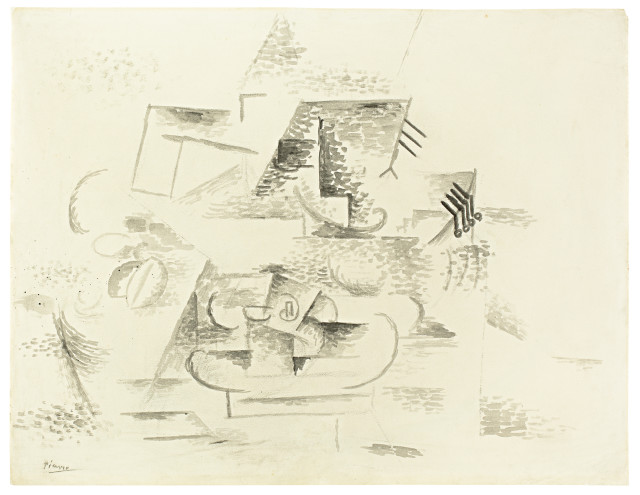- EN
Log in
- Live Auctions
- Past auctions
- More
- Gallery
- Art Dealing
- Publishing
- Kornfeld today
- The Story of Kornfeld
- Information





Málaga 1881 - 1973 Mougins
1910
Brushes in ink and watercolour
48,3x62,4 cm
Signed by the artist in pencil "Picasso" at lower left
Certificate of authenticity on photo by Claude Picasso, dated 6.5.2014, copy available
Collection Léonce Rosenberg, Paris
Collection Magda & Riccardo Jucker, Milan
Auction Sotheby's, New York, 7.11.2013, cat. no. 187; acquired there for
Private collection Europe
Mailand/Verona 1988-1989, Società per le Belle Arti ed Esposizione Permanente/Palazzo Forti, Modigliani a Montparnasse 1909-1920, reprod.
Mailand 1994, Fondazione Antonio Mazzotta, Da Klimt a Wols, cat. no. 62, reprod.
Rom 1998-1999, Palazzo delle Esposizioni, XIII Quadriennale, Valori Plastici, cat. no. 43, pag. 214, reprod.
Mailand 2003, Claudia Gian Ferrari Studio di Consulenza per il '900 Italiano, Natura morta natura viva nella pittura del Novecento, cat. no. 1, reprod.
London 2016, Omer Tiroche Gallery, Picasso on Paper
Mounted on a thin Japan paper. Two restored tears at the top and bottom
Picasso's involvement with the works of Paul Cezanne led to the development of Cubism. The 1910 print offered here belongs to the first phase of this new movement, which is called "analytical Cubism". Picasso tried to achieve a new rhythm of form by "opening up" the depicted objects. In doing so, he did not want to depict them illusionistically, but rather to explore their physicality and position in space and to realise them artistically. Again and again, similar "set pieces" can be found in these compositions, such as guitars, shells, violins or vases - in the black watercolour offered here, their deconstruction can be recognised very well. A large-format and excitingly composed, early cubist work.
1910
Pinsel in Tusche und Aquarell
48,3x62,4 cm
Unten links vom Künstler in Bleistift signiert "Picasso"
Echtheitsbestätigung auf Foto von Claude Picasso, datiert vom 6.5.2014, liegt in Kopie vor
Slg. Léonce Rosenberg, Paris
Slg. Magda & Riccardo Jucker, Mailand
Auktion Sotheby's, New York, 7.11.2013,
Privatsammlung Europa
Mailand/Verona 1988-1989, Società per le Belle Arti ed Esposizione Permanente/Palazzo Forti, Modigliani a Montparnasse 1909-1920, reprod.
Mailand 1994, Fondazione Antonio Mazzotta, Da Klimt a Wols,
Rom 1998-1999, Palazzo delle Esposizioni, XIII Quadriennale, Valori Plastici,
Mailand 2003, Claudia Gian Ferrari Studio di Consulenza per il '900 Italiano, Natura morta natura viva nella pittura del Novecento,
London 2016, Omer Tiroche Gallery, Picasso on Paper
Aufgezogen auf ein dünnes Japan. Oben und unten zwei restaurierte Einrisse
Die Auseinandersetzung mit Werken von Paul Cezanne führte bei Picasso zur Entwicklung des Kubismus. Das hier angebotene Blatt von 1910 gehört in die erste Phase dieser neuen Strömung, die man als "analytischen Kubismus" bezeichnet. Picasso versuchte mit einem "Öffnen" der dargestellten Objekte einen neuen Formenrhythmus zu erreichen. Damit wollte er diese nicht illusionistisch darstellen, sondern ihre Körperlichkeit und Position im Raum erforschen und künstlerisch umsetzen. Immer wieder finden sich ähnliche "Versatzstücke" in diesen Kompositionen, etwa Gitarren, Muscheln, Violinen oder Vasen – im hier angebotenen Schwarzaquarell sehr gut in ihrer Dekonstruktion zu erkennen. Eine grossformatige und spannend komponierte, frühkubistische Arbeit






